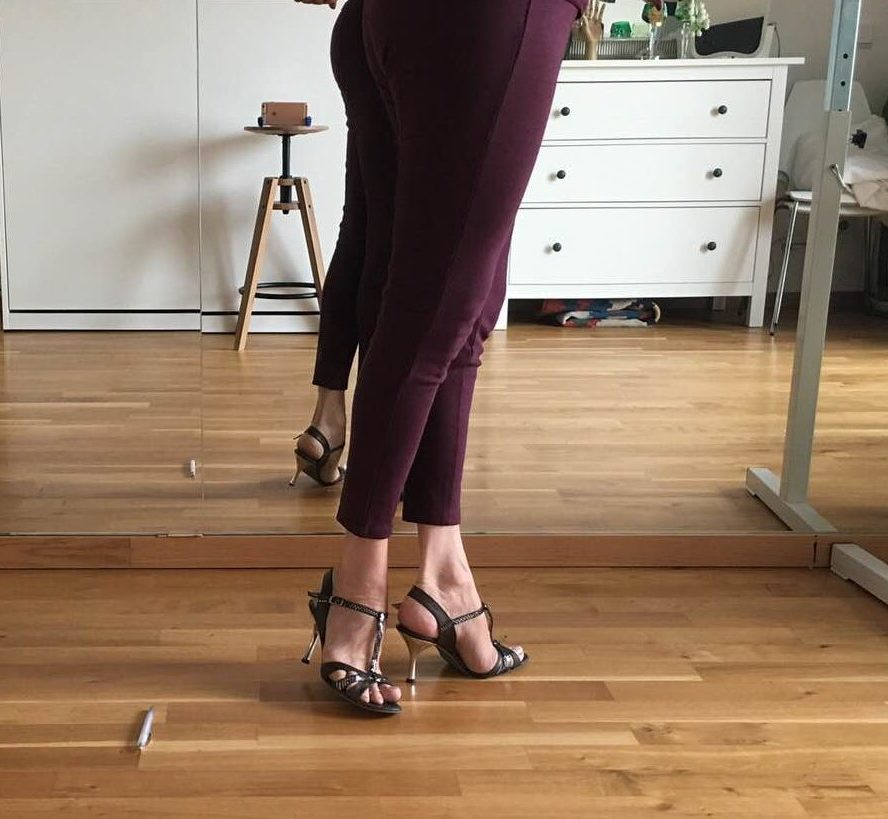In connection to last lesson,where we discussed the front ocho, I will today continue to explore the back ocho. Also called back cross, which is quite similar in movement with the front ocho, just with oposite direction. A small figure consisting of two basic technics:
The back ocho. ( back cross )
In this article I explore about the “ocho atras” regarding the technical and musical process.
First I explain the complex technic by cutting down the movement in 4 parts;
the preparation (a) the slide, project and transfer (b) the push, point and stretch (c) and the final relax and pivot (d) .
Finally I will show different applications to the music, similar to the lesson Nr 6, the cross in 1,2 and 4 beats.
Technical perspectives of the back cross.
Preparation a)
Her weight is on one leg with the free leg between her and the leader. She prepares her streched free leg behind her standing leg.
 Point and project for a small back cross (b)point and stretch the leg for weight transfer
Point and project for a small back cross (b)point and stretch the leg for weight transfer

here for big ocho (b)
She further extends her free leg for sliding . In this moment she will pivot a little in her standing leg, in order to get her heel a bit to the side, then she finish the transfers by sending all her weight backward with a push from her standing leg.
Depending on the size of the front ocho, a small one, or a huge dynamic one , or even something in bewtween, she will just relax her knee or bend her standing leg a little more in order to create more momentum for a much bigger step. More about this technique here.
Push and point for weight transfer (c)
Once she has arrived with all her weight on the new standing leg, she points her toes of the departing leg and press them into the floor . This enables the leg to reach a full stretch.

Lift knee cap and collect for pivot (d)
The energy she receives from the relaxing free leg together with the twist in her spine she will transform into the pivot.Then she will lift the knee cap of the departing leg a little in order not to scratch the floor, while she collects to zero.

to be repeated (a) for an other back cross.
Shall the leader want to stop the series of ochos he will lead you a small pivot just to come back to the frontal zero position.
During the process her upper body stays connected with the leader. (While practicing on the barre she is facing the mirror all the time, while her hands holding on the barre ) The hips are activ and facing the oposit direction of the movement. The torso isolates in the waist line. This action needs lots of preparation. It is beneficial to do latin dance or bellydance, or diciplines like Yoga and Pilates to work on flexibility in the spine.
Application to the music.

The back ocho can be danced in different rhythms. Usually she will need 2 beats to complete the movement. Step in the strong beat and pivot in the low beat.
Depending on how the dancers will interprete the music, they may use 1 beat ( different technique applies) or the movement will be stretched to a whole bar ( 4 beats). When the ocho is danced over a full bar , the lady will step in the 1. beat and then devide the rest of the movement to her own interpretation (embellishments) until she will finish with the pivot in 4. For these slow ocho over one bar you might want to perform to slow melodical music with deep steps.
Exceptions :
For ochos in 1 beat you will either use the preparation position and pivot and weight change in one beat or you stay in zero position and combine weight changing with small pivots. Same technic can be used for mini ochos in double time.
Common mistakes during the back cross:
- Pivoting with two feet or changing weight during the pivot.
- Finish the pivot, think of always of turn a little bit more than needed to be sure you have space for your free foot to pass through. Make sure that you are not stumbling over your toe.
- bending both knees together during the movement.
follow to next lesson: the cross
See my program for ladies tango techniques and tango milonguero
Take your space in my Ladies Tango Escape

